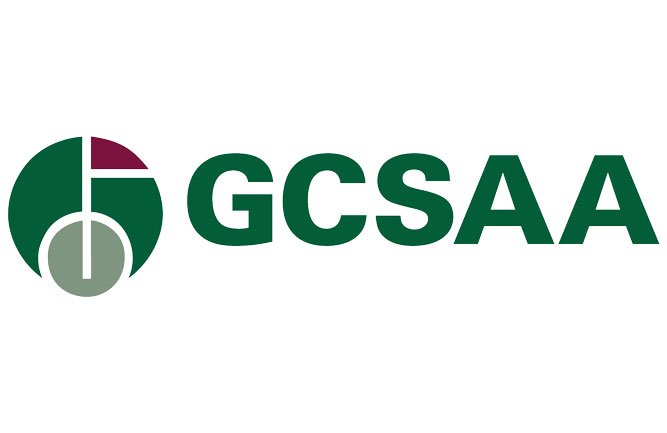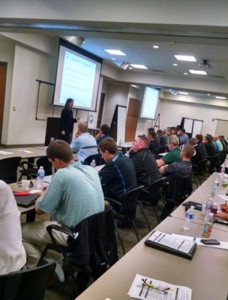The Golfdom Report: 2014
From concerns over the Affordable Care Act to how the GCSAA is currently performing, Golfdom readers share their thoughts and feelings on the state of their profession.
Things are looking up… but maybe wait a few more months before you buy that fancy new car.
That’s what the results of our late 2013/early 2014 Golfdom survey showed us. We received 467 responses to our 20 questions. The results of that survey are presented here (with the exception of a few answers that we’re stashing away for future feature stories.) We’ve also included some historical results from past Golfdom Reports to see how answers have changed over the years.
We learned that confidence in the industry remains steady, but we’re probably not out of the woods yet. Only about half of you received a raise in 2013, and that drives us crazy. Rounds played? That one was all over the board.
Big winners this year include maintenance budgets (85-percent of respondents expect the same or more in their budgets in 2014); the GCSAA (an 80-percent approval rating! See below); and regional/chapter meetings (69 percent reported that attending their regional/chapter meeting was more important than attending the Golf Industry Show.)
We were also excited to see our own approval rating go up this year: 51 percent stated Golfdom was their favorite magazine in the industry, up from 45 percent last year. Sure, it was our survey, but we’re still happy to see the uptick.
Read on to see how the most valued readership in the industry sees the future of the golf maintenance business.
Confidence remains steady
Survey shows confidence in industry remains steady in 2014.
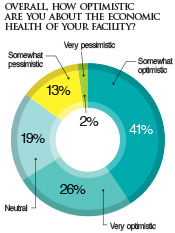 From 2002 to 2013, there has been little movement on the needle when it comes to confidence in one’s facility.
From 2002 to 2013, there has been little movement on the needle when it comes to confidence in one’s facility.
In 2002, 2007 and 2013, the number has remained steady: 67 percent of readers report being very optimistic or somewhat optimistic in the economic health of their facility. In 2013, only 13 percent report being somewhat pessimistic, while only two percent said they were very pessimistic.
Golf Course Superintendents Association of America (GCSAA) CEO Rhett Evans says he believes that 2014 will be the strongest economic year in three years. But he still sees what he calls “a struggle.”
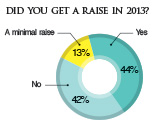
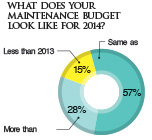
 “I think courses have weathered the storm to a degree, but we’re not out of the woods yet. There’s still a lot of competition, there’s still a lot of things we have to work on as an industry,” Evans says. “We still have to figure out ways in which we can adapt to the current golfing public. They’re wanting to spend less time on the course and they want to pay less. All of those things are going to create challenges for clubs, municipalities, semi-privates to compete for that audience.”
“I think courses have weathered the storm to a degree, but we’re not out of the woods yet. There’s still a lot of competition, there’s still a lot of things we have to work on as an industry,” Evans says. “We still have to figure out ways in which we can adapt to the current golfing public. They’re wanting to spend less time on the course and they want to pay less. All of those things are going to create challenges for clubs, municipalities, semi-privates to compete for that audience.”
Mike Hughes, CEO of the National Golf Course Owners Association (NGCOA), says he has a few reasons he’s forecasting an improved 2014. One reason is the uptick he’s witnessing in the 2014 Golf Industry Show numbers.
“There are some objective measures I look at that tell me we’ll see some upticks in 2014,” Hughes says. “GIS exhibitor sales are up, and that’s a good barometer. Also, our (NGCOA member) registrations are up substantially over (the 2013 GIS in) San Diego. Our attendance is up over 40 percent from what we had in San Diego.”
Hughes also notes that a combination of the dropping unemployment rate, increased consumer confidence, and the many programs to get more golfers into the game should all be good for business.
Another variable for golf’s health is always the weather. PGA PerformanceTrak, a cooperation among the PGA, NGCOA and other allied partners, is the single largest source of rounds played data in the industry. PGA PerformanceTrak reported a drop in playable days of 6.7 percent through September 2013. The National Golf Foundation was anticipating a year-end loss of four percent from 2012 when it comes to rounds played. But 2012 was a particularly favorable year for golf weather, witnessing a rounds played increase of 5.7 percent.
“Hopefully we’ll have a good weather year,” Evans says. “When you look at where some clubs are when they closed 2013, with their revenue, they saw some slight upticks in some areas. The cost of doing business — the products, services, labor, all of those things are still going to be a challenge. But I would say (2014) will be a slight increase from 2013.”
– By Seth Jones
Healthcare concerns
 With Obamacare, courses add a new challenge to the plate.
With Obamacare, courses add a new challenge to the plate.
The Affordable Care Act, commonly known as Obamacare, has caused many questions and worries over the last several months.
Changes are always unnerving and this legislation is full to the brim with alterations. Everyone is learning to navigate their way through the changes, however what do these changes mean for the golf industry?
Almost half of the respondents reported there has been no change at their facility due to the Affordable Care Act. Meanwhile, 25 percent report their employer has changed their healthcare options, and another 25 percent report that there has been no changes yet, but they expect them. Only three percent reported that their employer has already stopped offering healthcare for some employees.
Jared Viarengo, CGCS and General Manager at the Applebrook GC in Malvern, Pa., has thought a lot about the impact of the Affordable Care Act on his course.
“I think it’s going to have an impact on the majority of courses that have more than 50 full-time equivalent employees and are bound by the law (to provide insurance), which in our case we are and we’re not even that big of a club,” says Viarengo.

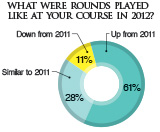 He explained that the phrase “full-time equivalent employees” is vital when working out the formula of the Affordable Care Act. “That’s really anybody that puts in a certain amount of hours and because we’re in the mid-Atlantic and Philadelphia, it’s tough for us. Seasonal under the Act is 120 days, which seasonal for us is guys who work seven or eight months, so it’s not even close,” says Viarengo. His club has about 90 employees at any one time.
He explained that the phrase “full-time equivalent employees” is vital when working out the formula of the Affordable Care Act. “That’s really anybody that puts in a certain amount of hours and because we’re in the mid-Atlantic and Philadelphia, it’s tough for us. Seasonal under the Act is 120 days, which seasonal for us is guys who work seven or eight months, so it’s not even close,” says Viarengo. His club has about 90 employees at any one time.
Viarengo predicts that many clubs may alter how they schedule their laborers in order to avoid having 50 full-time equivalent employees. Workers may be given fewer hours or transitioned into working in shifts. Courses may do whatever is needed to remain under the magic number of 50.
“If you’re at a club and you’re at 51 full-time equivalents, it’s a huge savings if you can get to 49. So if you can eliminate an employee or make some adjustments in your labor force, you’re going to do it to try to get out from underneath it,” says Viarengo.
Front and center are worries over what the Affordable Care Act will do to a golf course’s budget. Budgets for course maintenance can be tight on a good day, but the added expenses of the legislation may lead to changes for courses everywhere.
Matt Kregel, superintendent at The Club at Strawberry Creek in Kenosha, Wis., is unsure what the future holds as far as the Affordable Care Act is concerned.
“We really don’t know yet because as we’re learning more about it, some things are changing that we thought were going to apply to us,” says Kregel. He pointed out a fact that has frustrated many — the ever-evolving nature of the legislation. “There’s some specifics that we know we’re going to have to encounter, but as they evolved or get more into the actual law, and all of the documents associated with it, we’re learning a little bit more each time something new comes out.”
The future can be difficult to predict and crystal balls just aren’t what they used to be. For Viarengo and Kregel they can only wait and see what unravels. Kregel says that’s exactly what they will do. “We want to wait and see what it is specifically required of a golf course and what we’ll have to do to comply with that.”
– By Molly Gase
Feel the love
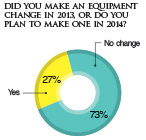 Good news for the National: Golfdom readers approve of the work they’re doing by a margin of 4 to 1.
Good news for the National: Golfdom readers approve of the work they’re doing by a margin of 4 to 1.
There have been a lot of changes at GCSAA headquarters in Lawrence, Kan. From the implementation of a field staff to adjustments in dues and the GIS schedule, the national association for superintendents has kept busy.
And it has caught the attention of readers. A whopping 81 percent of readers reported they were satisfied (73 percent) or extremely satisfied (9 percent) in the GCSAA’s performance. Only 18 percent reported dissatisfaction with the 88-year-old association.
“From my years of experience, GCSAA is trying to stay ahead of the times and change as best it can,” reported one participant in the survey. “GCSAA is making the most out of a challenging economic time but still supporting us with its whole heart.”
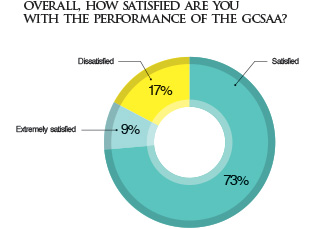 “They do so much that is never really touted to their membership,” reports another reader. “Things like their government relations, or advertising the role of the superintendent.”
“They do so much that is never really touted to their membership,” reports another reader. “Things like their government relations, or advertising the role of the superintendent.”
According to Billy Hausch, superintendent at the Nicklaus Club of Monterey (Calif.), the GCSAA has adapted to the times well.
“As a whole, the organization is finding ways to better serve their members in a modern setting,” he says. “They’ve become technologically advanced… For example, I can take care of a lot of my stuff online, I don’t have to call someone anymore.”
Of course, there are still those who feel the GCSAA has let them down. “I feel that I don’t get enough out of the membership price,” reports one reader, while another more harshly states, “They are creating a group of branded elitists. I dare say they are becoming a burden to the mid- to low-budget superintendent, instead of an empowering supporter.”
And yet others place blame on themselves. “They do a pretty good job — it’s mostly my fault for not taking advantage of all the areas offered!”
– By Seth Jones
Supers give an assist
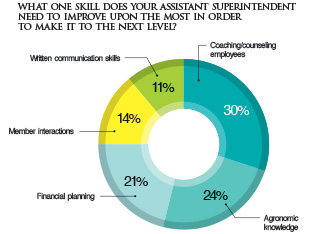 For assistants who have wondered what skill they most need to work on, we have the answer. OK, make that more than one answer…
For assistants who have wondered what skill they most need to work on, we have the answer. OK, make that more than one answer…
The role of a superintendent is a multi-faceted one. For assistant superintendents, there are a lot of skills to pick up. These range from communication skills, financial planning and agronomic knowledge to leadership skills and member interaction. Each skill is important for an assistant to master in order to move into the role of superintendent.
When asked what skills their assistants needed to improve upon to move forward in their careers, superintendents were quick to speak up. However, they did not all have the same thing to say. The same goes for the results of our survey: Coaching and counseling employees was the most popular response at 30 percent. Agronomic knowledge (23 percent), financial planning (21 percent) and member interactions (14 percent) were also popular choices.
John Gosslin, superintendent at Aronimink GC, Newton Square, Penn., pointed out both the strengths and weakness of his assistants. “They are all very good technically these days, but everybody could always work on their leadership skills, dealing with people, negotiations, leading people that are all from different cultures and different age groups and that’s just something you can’t get in school. You can only get that once you get in the workplace,” says Gosslin.
Eric Frazier, Director of Agronomy at Willow Oaks CC, Richmond, Va., finds some assistants lacking when it comes to staff management. “They manage the staff directly, but they don’t have to manage the human resources piece, so bridging the gap between the H.R. piece and the staff management, I think is a huge area for assistants to grow,” says Frazier.
Learning to lead staff is important, but Jackson Reiswig, superintendent at Coral Creek Club in Placida, Fla., suggests adaptability.
“It would definitely be an ability, for lack of a better term, to roll with the punches and adapt. You have to be able to go from speaking with a CEO of a fortune 500 company to a laborer who went through four grades of school,” says Reiswig.
Assistants, many constantly glued to their smart phones, do have a skill that both Gosslin and Frazier value: communication. Being able to communicate well is something that Frazier finds very important at his private club.
“I think you can’t communicate too much. Communicate to your staff, communicate to your managers, communicate to the membership or your golfers,” says Frazier.
Only 11 percent of responses selected communication skills as something their assistants needed to improve upon. Constant communication seems to be a staple of younger generations and for Gosslin, that is a positive.
“They are usually really good communicators with all of the tech. I find it easier to communicate with assistant superintendents these days just because it’s easy. We basically can stay in touch 24 hours a day,” says Gosslin.
– By Molly Gase









